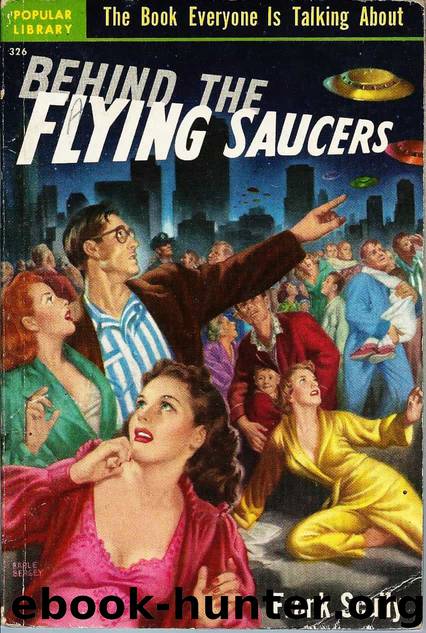Behind the Flying Saucers by Scully Frank

Author:Scully, Frank [Scully, Frank]
Language: eng
Format: epub
Tags: Science Fiction
ISBN: 9781537492179
Google: lAcmvgAACAAJ
Amazon: B0000CHU45
Goodreads: 6012580
Publisher: Holt
Published: 1950-01-01T05:00:00+00:00
An Aerodynamic Correction
THERE’S an aerodynamic proverb, or if there isn’t, there ought to be, that everything has an end-except a flying saucer, which has neither a beginning nor an end.
Exceptions to this might be taken by Leo Bentz, George de Bay and Jacque Fresco, all of whom have either seen or designed flying saucers many years ago. Bentz, an old-time builder of automobiles, said he saw a confidential demonstration of a flying saucer in Griffith Park, California, as long ago as 1928. It was designed by George de Bay. It skipped through the air like a flat stone, or better, a saucer with its curved side toward the earth. Thus it worked on a vacuum principle, which de Bay explained would require ten times less power for propulsion than what was used at that time. It was not, however, designed to carry a pilot or crew. Bentz lost sight of de Bay before the war and believed he had gone to Russia.
In 1938 Jacque Fresco designed a flying saucer but at that time the aircraft companies said the model was too far ahead of anything they could handle and it was shelved while he worked on a more conventional job, which he did at Pearl Harbor, just before the war, and some Buck Rogers contributions which were his lot at Wright Field during the conflict. p small dark man with the eyes of a fox terrier and a mind as sharp as an arctic wind, Fresco belongs to the “believe only what you can measure” school of science. Flying saucers might be mirages reflecting from round-shaped aluminum-painted oil tanks, he suggested. “They might seem to move in the sky as the sun moved, thus confusing people either on the ground or aboard planes.”
But, even so, disk-shaped aerial ships he thought had a sound aerodynamic future. But he wouldn’t go beyond hydrogen gas and turbojets as a means of propulsion. In fact when he heard somebody was offering $25,000 for a saucer that would fly he said that would be like taking candy from a baby.
“I can build one for $15,000 and make it fly fast enough to pull a pilot out of his skin,” he said, “and I’m working on a way to make even him survive the experience.”
The first time I hinted to him that the flying saucers under examination were in all likelihood powered by magnetic energy, the remark stopped his stream of speech and turned him for a moment into a mute, inglorious Milton.
“No aircraft engineer will go that far,” he warned. “Mind, I am not stressing flying saucers in the first place, for the simple reason the industry doesn’t want them, but if they’re made in the future, they will have to be along conservative lines.” I leave it to readers to judge what he considers conservative lines.
In the aircraft industry Fresco is known as the man who is forever twenty years ahead of his time. Up to the day I consulted him on flying saucers,
Download
This site does not store any files on its server. We only index and link to content provided by other sites. Please contact the content providers to delete copyright contents if any and email us, we'll remove relevant links or contents immediately.
| Ancient & Controversial Knowledge | Ghosts & Hauntings |
| Hermetism & Rosicrucianism | Magic Studies |
| Occultism | Parapsychology |
| Supernatural | UFOs |
| Unexplained Mysteries |
Animal Frequency by Melissa Alvarez(4399)
Sigil Witchery by Laura Tempest Zakroff(4181)
Real Magic by Dean Radin PhD(4077)
Fingerprints of the Gods by Graham Hancock(3943)
Aleister Crowley: The Biography by Tobias Churton(3589)
Journeys Out of the Body by Robert Monroe(3572)
The Rosicrucians by Christopher McIntosh(3467)
Alchemy and Alchemists by C. J. S. Thompson(3452)
Mysteries by Colin Wilson(3399)
Hitler's Monsters by Eric Kurlander(3270)
The Hatha Yoga Pradipika (Translated) by Svatmarama(3235)
John Dee and the Empire of Angels by Jason Louv(3132)
Wicca: a guide for the solitary practitioner by Scott Cunningham(3127)
Infinite Energy Technologies by Finley Eversole(2939)
Book of Life by Deborah Harkness(2869)
Dark Star Rising by Gary Lachman(2830)
The Book of Lies by Aleister Crowley(2802)
Aliens by Jim Al-Khalili(2788)
To Light a Sacred Flame by Silver RavenWolf(2770)
